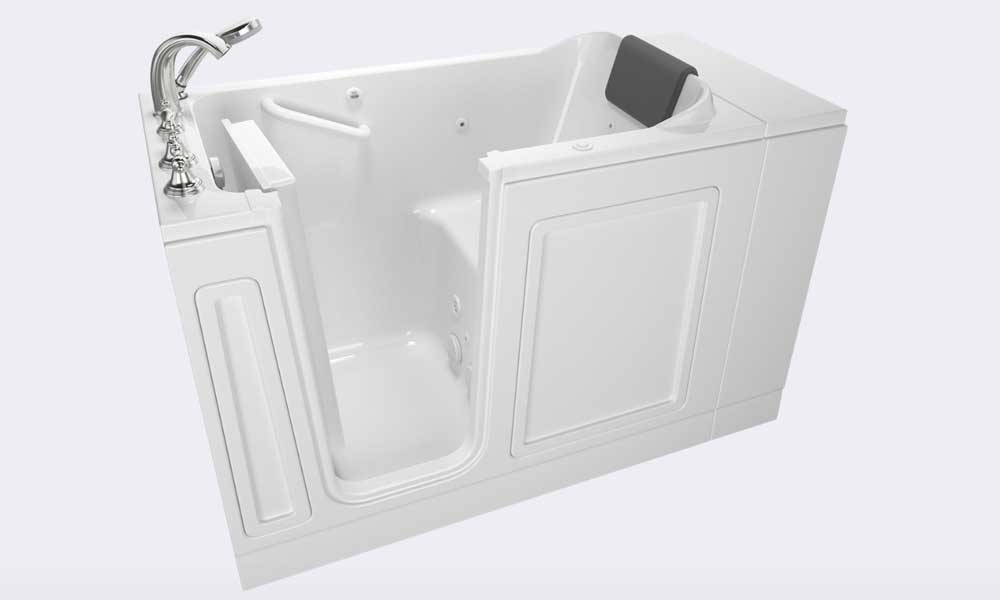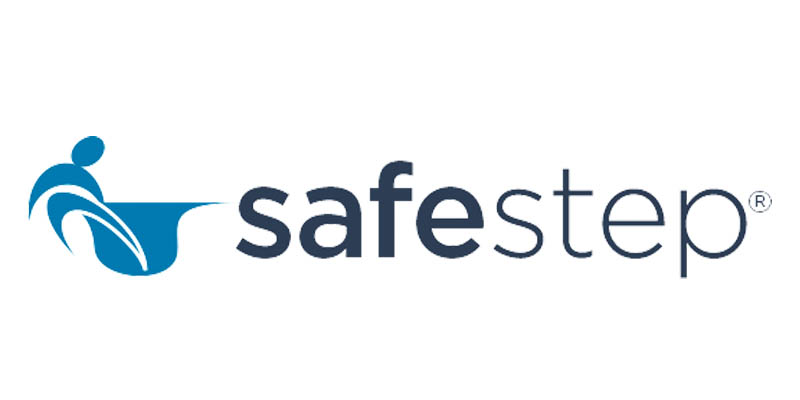Falls are a leading cause of death and injury among the elderly. Traditional bathtubs are particularly dangerous for seniors with weakened muscle strength, mobility, or balance.
One way to improve safety and independence in the bathroom is to install a walk-in tub. Walk-in tubs have a door that allows you to walk into it without climbing over a steep edge. When the door closes, it seals to retain the bath water, and remains closed until the water fully drains. Walk-in tub doors open outward into the bathroom but can be designed to open inward to accommodate a wheelchair or save space in smaller rooms.
Safety features like these prevent water spills and slip hazards while also providing therapeutic relief to physically impaired or overweight persons who might benefit from hydrotherapy or regular soaking sessions. The only downside? Installing a walk-in tub can be expensive.
Walk-In Tub Costs Vary by Type
The cost of a walk-in tub ranges from about $2,300 for a basic soaker to $25,000 for a two-person tub offering a spa-like experience. Most seniors can find and install an ADA-approved walk-in tub between $5,000 and $10,000 if there are no other modifications needed to the plumbing, water heaters, or widening the footprint of a bathroom to accommodate the tub. Costs depend, and vary widely, on features like size, number of jets, seat type, and therapeutic and design options. Larger tubs cost more and drive up the utility bills used to run and heat the water.
- Standard walk-in tub: $2,500 to $5,000
- Air bath or hydrotherapy tub: $5,000 to $10,000
- Bariatric bathtub: $7,000 to $10,000
- Combination bath (air and hydrotherapy) tub: $7,000 to $15,000
| Brand | Top Features | Price |
|---|---|---|
| Kohler | – Soaker tub with grab bars – Hydrotherapy and air jets | $2,000 – $15,000 |
| American Standard | – Lifetime warranty on bath and installation – Quick drain – Self-cleaning system | $4,000 – $11, 000 |
| Safe Step | – Hydrotherapy – Aromatherapy – Chromotherapy for arthritis | Starting at $10,000 |
| Boca | – Lowest step (two inches) – Heated seats – Auto-dry features | Starting at $7,000 |
| Universal Tubs | – Wheelchair-accessible – Stream jets | $2,000 – $8,000 |
| Ella | – Two-seater tubs – Petite and tall sizes | $4,000 – $10,000 |
From Our Expert: As an accessibility consultant, I’ve found that almost every installation requires extensive upgrades to accommodate the tub—especially in homes that are more than 20 years old. This can vary from water heater and piping upgrades to enlarging the bathroom. Clients should expect to pay more than the initial price and source several estimates from installers. Consult with trusted family and healthcare professionals before deciding. Sometimes, a walk-in shower is a smarter choice and less expensive than a tub.
Dawn Heiderscheidt, OTR/L, ECHM, CAPS
Walk-In Tub Installation Costs
The average cost to install a walk-in tub is between $2,500 and $8,000. Though the task of installing a standard walk-in tub isn’t overly costly or complex, it will take some time to remove the old tub and the tub surround. Account for around six to eight hours of labor. Most brands include installation fees with purchase.
Installation costs will increase if you buy a walk-in tub with more features beyond what’s included in a standard model. For example, the installation might require additional plumbing, tile, and electrical work if you choose a deeper tub with a higher water capacity or one with heated seats. If the tub is equipped with hydrotherapy or air jets, the installation expense increases substantially—around $1,500 to $5,000.
A tub can hold 50 or more gallons, so you might need to upgrade your water heater or plumbing to match. Talk with the brand and installation team to determine whether these updates are included in your walk-in tub and installation estimate, and be mindful of how these upgrades may impact your monthly bills.
Walk-In Tub Maintenance and Warranties Cost
Maintenance costs are usually low for walk-in tubs, though higher-end models with mechanical elements require regular upkeep. You can clean jetted tubs every few months with a specialty cleaner and have a plumber or electrician inspect the motors every few years.
Reputable manufacturers like the brands above offer long-term warranties and customer service plans. When comparing walk-in tub companies, look for lifetime guarantee warranties and other service protections that will ensure you can use your tub for years to come.
Learn more: How to Care for a Walk-In Tub
Walk-In Tub Cost Factors

The features of a walk-in tub influence the price and range from basic to luxurious.
- Easy-to-reach controls and anti-slip surfaces: Walk-in tubs usually come with a hand-held shower head for sit-down bathing.
- Low step-in threshold: The standard threshold is four to seven inches high, but some manufacturers offer even lower entries to reduce trip hazards.
- Safety-tested features: Tubs with CSL/UL approvals meet safety and sustainability standards. Health associations that have reviewed the product, like the Arthritis Foundation, may help you decide on one brand over another.
- Fast draining: Choose a walk-in tub with drain technology that allows water to drain or fill quickly. Tubs furnished with fast drains can empty in about two to three minutes. Remember, walk-in tubs can hold 50 to 80 gallons of water, so this upgraded feature eliminates the waiting process.
- A backrest: True comfort soaking requires a backrest to ease sore muscles and joints—especially if the backrest is heated.
- Air and hydrotherapy: An air bath provides relief to those with diabetes or circulation issues by pushing millions of tiny air bubbles through small air jets. A hydrotherapy or whirlpool bath provides deep tissue massage and can soothe muscle aches. A bariatric bath works well for larger individuals or those with mobility problems. Combination tubs offer air and water jets with the option of switching between the two settings.
Important consideration: When shopping for a tub, prioritize function and safety followed by health-related functions. Before purchasing a tub, you’ll need to consider your future needs as well. Door widths and mobility aides can greatly impact what door width you need and whether any door options will fit your devices. If you can’t functionally use a walk-in tub now and in the future, paying for one will be pointless.
Paying for a Walk-In Tub
Medicare does not cover the costs of a walk-in bath, but Medicaid or Veterans Affairs might cover a portion of the walk-in tub if you have adequate documentation from a doctor. This may include a prescription, letter of medical necessity, and/or evaluation from a rehab professional. Medicaid coverage varies from state to state, so research your state’s policies, or contact your Medicaid provider or support coordinator to determine the financial assistance available to you.
The U.S. Department of Agriculture’s Rural Development Program provides grants and loans to low-income, rural homeowners to make home modifications such as remodeling a bathroom to allow for a walk-in tub. This program also oversees the Single Family Housing Repair Loans & Grants program, which offers loans with a 1% interest rate to assist low-income seniors with improving homes for safety.
Some states may have additional funds or low- to no-interest loans for those who demonstrate a medical need. For example, the Pennsylvania Assistive Technology Fund can cover medically necessary things with a 0% interest loan up to $7,000.
Are Walk-In Tubs Tax Deductible?
The IRS allows you to deduct certain medical expenses from your taxes, including a walk-in tub. But again, you’ll need to have a prescription from your healthcare provider deeming it necessary for health reasons. With this letter, you can deduct part of the tub expense for the year the doctor advised you to install it. Always check with a tax professional when planning to claim these benefits.
If your walk-in tub is not tax-deductible or covered by insurance, talk to the tub dealer or manufacturer about financing options. Most companies offer coupons and low-interest payment plans for qualified customers.



